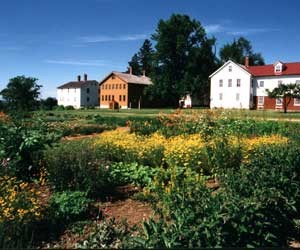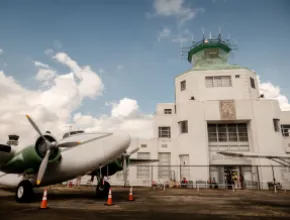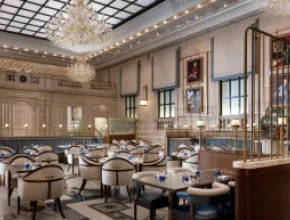The stories of how the American West was settled are as varied as the Western landscape itself. In Hawaii, there’s the story of immigrants who streamed in from places as far-flung as Portugal and Japan to work in the sugarcane fields. In Oregon, there’s the story of hardy pioneers who survived the rigors of the Oregon Trail to cultivate the fertile Willamette Valley.
In California, there’s the story of the ’49ers who came to strike it rich, only to end up enriching the shopkeepers in the rough-and-ready Gold Rush towns that sprang up to serve them. In New Mexico, there’s the story of people who established thriving communities atop high-desert mesas centuries before Europeans arrived on the scene.
Fortunately, all of these stories have been preserved in historic enclaves that visitors can explore. All are equipped for group tours, while also offering museums and other venues that can handle a variety of events.
New Mexico’s Pueblos
Perched on a high mesa 65 miles west of Albuquerque, Acoma Pueblo, also called Sky City, is a community believed to date from the 12th century or even earlier. Today, Acoma is home to about 50 year-round residents who live in a village of earthen houses that surround the massive San Estevan del Rey Mission, completed in 1640.
Pueblo members lead guided walking tours of Acoma, which is accessed by vans making the steep journey up the high sandstone mesa from the Sky City Cultural Center below. The 90-minute tours share oral traditions and include the chance to stop and shop for the highly prized Acoma pottery as well as jewelry, yucca-brush paintings and other local artwork.
"The tours are a very beautiful, possibly even life-changing experience," says Arlene Schiffer, president of Passport DMC, a destination management company based in Santa Fe, N.M., which arranges outings to Acoma for
Both Sky City Cultural Center, which includes a gift shop and cafe, and the adjacent Haak’u Museum are new additions to Acoma. The museum offers a permanent exhibit on the history of Acoma, while other galleries showcase changing exhibits of Southwest art created by Native American artists.
Located about an hour outside of Santa Fe on the Santa Clara Pueblo, Puye Cliffs is another historic settlement conducive for group visits. The ancestral home of the Santa Clara people, Puye Cliffs consists of two levels of cliff dwellings that were inhabited from the late 1100s to 1580.
The site also includes the remains of a Harvey House, one of a series of hotels built by the Fred Harvey Company to provide amenities for tourists in the late 1800s. As with Acoma, guided tours are provided by pueblo residents.
According to Schiffer, Puye Cliffs is a versatile venue for group programs.
"We have taken over the site for an afternoon for a group who wanted a private experience," she says. "We had craft demonstrations, Native American dancers and a lunch of local specialties such as fruit empanadas. The pueblo has worked hard to create this as part of an economic development program without taking away from the truth and honesty of the place."
Old Sacramento
Few places are as equipped with built-in decor and atmosphere as Old Sacramento, a 28-acre historic district just across the river from the commercial hub of California’s capital city. Established to serve the gold-seekers headed for the Sierra foothills, Old Sacramento, through diligent restoration efforts, charms modern visitors with its wooden sidewalks, horse-drawn carriages, old-fashioned curio shops and saloons housed in 1850s buildings. Also on hand are costumed interpreters decked out as prospectors and saloon girls.
"The gold miners would come to San Francisco, then head up the river, stopping here to buy their picks and shovels. That’s the genesis of Old Sacramento," says Stephen Hammond, president and CEO of the Sacramento CVB. "Now it’s one of the largest attractions in Northern California."
For meetings, Old Sacramento is a veritable goldmine of off-site venues. Among the most versatile is the California State Railroad Museum, which offers North America’s largest collection of vintage trains—everything from early locomotives to a dining car from the 1930s that can serve as a venue for dinners or small receptions.
"The museum is very popular for opening night receptions," Hammond says. "You can do a variety of catered events there, including a California wine tasting evening for 600 or 700 people. Plus the group can enjoy some of the oldest and largest train engines in the world."
Other venues include the Sacramento History Museum, where exhibits shed light on the Gold Rush and other events in early California, and the Firehouse, an acclaimed restaurant with private dining spaces that include courtyards and wine cellars.
Docked in the river, the Delta King is a classic sternwheeler that once plied the waters between San Francisco and Sacramento. Now a small hotel, the vessel offers several
Oregon City
According to Western lore, fortune-seeking pioneers took a turn off the Oregon Trail to make way for California, while those of a more practical nature kept their wagons headed straight for Oregon. At the end of the trail lay Oregon City, a town south of Portland that today is filled with reminders of Oregon’s pioneer days, everything from historic homes to downtown murals depicting life on the 19th century frontier.
Overlooking Willamette Falls, the second-largest waterfall in the U.S., the Museum of the Oregon Territory is the place to get an overview of the history of what was called "Oregon Country," a vast territory that also encompassed what later became Washington and part of British Columbia. The museum’s top-floor Tumwater Room, which features cathedral ceilings and dramatically arched windows framing views of the falls, accommodates up to 300 guests for a reception.
Outdoor space for picnics and team-building activities is available at the End of the Oregon Trail Interpretive Center, which features a cedar woodcarving exhibit and a heritage garden planted with heirloom vegetables, ornamental plants and roses. A multimedia presentation focuses on the 2,000-mile westward journey on the Oregon Trail.
Oregon City also has an impressive number of historic homes open for tours, including the stately McLoughlin House, which dates from 1847. It was home to John McLoughlin, a fur trader known as the "Father of Oregon," who crossed the Rockies in 1824 and established a post for the Hudson Bay Company just north of Portland.
Other house museums include the Stevens-Crawford House, which has an antique toy collection and other memorabilia, and Rose Farm, a gracious home with a rose garden and second-floor ballroom where the first territorial governor was inaugurated.
Hawaii’s Plantation Village
Between 1852 and the end of World War II, nearly 400,000 immigrants came from China, Japan, Korea, Portugal, Puerto Rico, the Philippines and Okinawa to work on Hawaiian sugar plantations. This open-air history museum west of downtown Honolulu in Waipahu illustrates what life was like for those who worked in what was Hawaii’s leading industry for over 100 years.
Set on 50 acres at Waipahu Cultural Park, Hawaii’s Plantation Village consists of 32 authentic and replicated homes and community buildings that include a barber shop, library, camp office and plantation store. Photographs and personal artifacts tell the workers’ stories and also showcase the diverse ethnic traditions that would help shape Hawaii’s unique culture.
Surrounding the structures are examples of the trees and plants that the workers used for food, medicine and household materials. Also on the grounds is a plantation steam locomotive, typical of those used to haul the cane from the fields on a narrow-gauge railroad track.
Docent-led tours of Hawaii’s Plantation Village are available for groups. In addition, the complex offers picnic areas as well as an indoor
For More Info
Acoma Pueblo
505.552.1084
www.skycity.com
Hawaii’s Plantation Village
808.677.0110
www.hawaiiplantationvillage.org
Old Sacramento
916.442.8575
www.oldsacramento.com
Oregon City Chamber of Commerce
503.656.2274
www.oregoncity.org
Puye Cliffs
505.927.2731
www.puyecliffs.org







